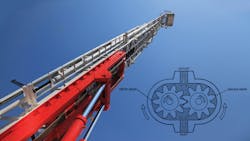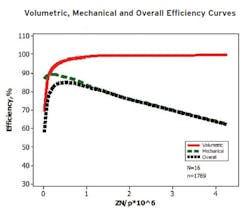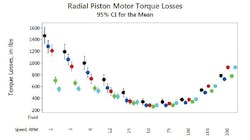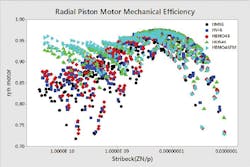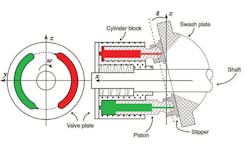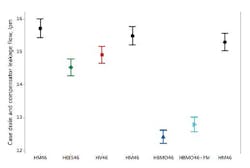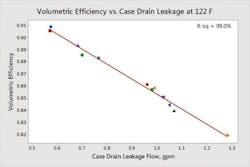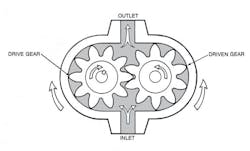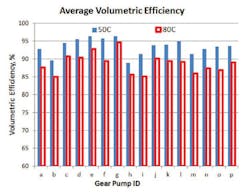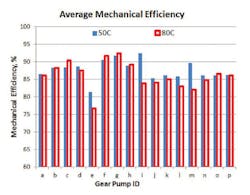Getting the Most Efficiency Out of Hydraulics
Fluid power systems consume between 2.25 and 3.0 quadrillion BTUs annually. That breaks down to roughly 1.2 quadrillion for mobile applications, 1.7 for industrial applications and 0.1 for aerospace applications. The average efficiency of these fluid power systems is 21%. Could fluid optimization reduce energy consumption and improve the efficiency of hydraulic systems?
Efficiency Basics
Hydraulic systems convert rotary mechanical power from engines and electric motors to fluid power by turning the input shaft of a pump. Hydraulic control valves direct the pump’s output to machine actuators that use cylinders and motors to convert fluid power back to mechanical power.
Hydraulic motors are like pumps that run backward; they convert fluid power to rotary mechanical power and can generate the high-power densities required by mobile machines. Hydraulic motors turn the drums on cement mixers, swing the booms on excavators, drive the cutting blades on rock-wheels, excite the eccentrics on paving machines and propel skid-steer loaders.
Unlike centrifugal pumps, in which flow depends on pressure, hydraulic systems use positive displacement pumps and motors in which flow is independent of pressure. No pump is 100% efficient, so pressure always influences flow to some extent.
Hydraulic systems produce kinetic energy in the form of flow and potential energy in the form of pressure. Thus, it is imperative to separate high-pressure and low-pressure zones in hydraulic systems. This requirement drives many design concepts in fluid power technology; moving machine components must seal at tribological interfaces to minimize leakage through gaps.
Internal leaks, the movement of fluids from high-pressure zones to low-pressure zones inside hydraulic components, reduce the amount of power a system can deliver. As system pressures and temperatures increase, pressure-driven flow losses through internal gaps also increase. This effect is more significant in mobile applications; the smaller oil reservoirs and heat exchangers required for mobile hydraulic systems means they operate at higher temperatures than industrial systems.
How Do We Measure Efficiency?
The overall efficiency of a hydraulic pump or motor is its volumetric efficiency multiplied by its mechanical efficiency. Volumetric efficiency relates to the output flow per revolution of the pump’s input shaft. It measures the pump’s ability to minimize leaks between high- and low-pressure regions. Mechanical efficiency relates to the motor’s output torque and is an indicator of the fluid’s ability to prevent friction. At high pump pressures and low motor speeds, where most practical operations take place, volumetric efficiency increases rapidly with increasing pump speed (or fluid viscosity), and then levels off. Meanwhile, mechanical efficiency decreases nearly linearly as the pump speed (or the viscosity of the fluid) increases. This relationship is commonly illustrated using a Stribeck curve, which plots efficiency as a function of speed, viscosity and pressure (load).
Fluid Requirements
Reliability and efficiency call for different properties in a hydraulic fluid. Reliability standards are well defined and required for all hydraulic fluids. They include viscosity, wear protection, thermal stability, corrosion inhibition, foam resistance, demulsibility (this measures an oil's ability to release water), oxidation life and cleanliness. Pressure-dependent fluid properties, which include bulk modulus, density and traction, can have a large effect on hydraulic system efficiency, but these properties rarely appear in hydraulic fluid specifications.
Bulk modulus represents the ratio of volume change to pressure change in a liquid. As a rule of thumb, the volume of a hydraulic fluid decreases by about 0.5% for every 1,000-psi increase in pressure. A fluid’s bulk modulus depends on pressure, temperature, chemistry and structural rigidity. Bulk modulus can affect pump losses (efficiency), sound transmission (noise generation) and system bandwidth (dynamic response, or how quickly the machine responds when the valve is shut). Bulk modulus also appears to affect leaks in the pump and control systems.
Density is a substance’s mass per unit volume and a function of intermolecular forces and chemical composition. An oil with a high bulk modulus is denser and, thus, less compressible than a conventional lubricant. Density factors can affect the pressure drop through valves and fluid conductors and, consequently, system efficiency.
Traction is the shear force transmitted across a lubricating oil film. It is the result of differences in velocity (which includes speed and direction) between the film’s upper and lower surfaces. A fluid’s traction coefficient is the ratio of traction force to normal load. It takes less energy to shear the film of a fluid with a low traction coefficient between two surfaces that are moving with respect to each other. A fluid with a low traction coefficient can reduce a motor’s low-speed torque losses (the difference between theoretical torque and actual torque caused by friction in the gaps).
Fluid Efficiency
Hydraulic motors. Hydraulic motor efficiency at low speeds or starting from a resting position often determines the design pressure and pump size required in a hydraulic machine. This is particularly true for machines that must start under load such as digging into a pile of dirt or lifting a shipping container. Just as an automobile is least efficient when it is stopped or moving slowly through traffic, hydraulic motors also are inefficient at low speeds. Reducing motor friction at low speeds improves efficiency by increasing the power available to engage the payload. Improving the motor’s performance can significantly affect the whole system’s efficiency.
To illustrate how a hydraulic fluid’s characteristics can affect a system’s performance, we compared five hydraulic fluids (each contains an ashless anti-wear additives).
- HM46. A high-performance Group I mineral oil for high-pressure hydraulic systems operating under moderate to severe conditions in mobile and industrial applications.
- HV46. A high viscosity index Group III oi, for heavy-duty hydraulic systems, with a high viscosity index for better temperature-viscosity performance.
- HEES46. A biodegradable oil based on synthetic esters, especially good if an incidental oil leak could harm water.
- HBMO46. A high bulk modulus oil based on Group V phenyl esters (aromatic compounds).
- HBMO46+FM. HBMO46 with a small amount of friction modifier additive. All properties other than traction coefficient are the same as for HBMO46.
These fluids were evaluated in axial piston, radial piston and orbital (geroler) motors, which show similar trends in torque losses as a function of motor speed. At low motor speeds, low-traction fluids (HEES46 and HBMO46+FM) exhibit half the low-speed torque losses of a conventional hydraulic fluid. Torque losses for all types of oil are similar at medium and high speeds, but they decrease and level out as the motor speeds up then increase slightly at the highest speeds.
Differences in mechanical efficiencies mirror the torque losses. Fluids without base stocks or additives that modify frictional characteristics have lower mechanical efficiencies at low-motor speeds. Efficiency increases with increasing speed up to a maximum and tapers off at higher values. The efficiencies of the fluids are similar at high speeds because hydrodynamic lubrication is at work and the fluids are the same ISO viscosity grade.
Hydraulic pumps. Piston pump–open loop: In an axial piston pump, an input shaft rotates the cylinder barrel. As the cylinder barrel rotates, the slippers slide on the swash plate creating a reciprocating piston motion that fills and empties the cylinder bore (see the illustration of valve plate, swash plate). Fluid expelled by the piston gets to the circuit through ports in the valve plate. The primary leaks are gaps in an axial piston pump at the cylinder barrel/valve plate, slipper/swash plate and piston/cylinder bore interfaces.
In an axial piston pump with pressure compensation, the swash plate angle automatically adjusts to compensate for changes in pump outlet pressure. Hydraulically, pressure compensation reduces the volumetric efficiency of a pump by redirecting pump outlet flow to the compensator control system.
In the graph comparing pump case and compensator flow losses for the five fluids, HM46 oil was the reference fluid and was evaluated at the start, middle and end of the test. The mean flow loss rate for the HBMO fluid was 20% less than that of the baseline HM46 oil. Flow losses for HEES46 and HV46 also were less than the HM46 baseline. The flow losses of HBMO46+FM were slightly higher than that of the HBMO46 base fluid, possibly due to the addition of the friction modifier or another change in fluid properties. The high bulk modulus fluid also reduced pump power losses, but pumping losses were not proportional to flow losses.
Piston pump—closed loop: In a closed loop pump system, a charge-pump feeds the oil into the hydraulic pump rather than gravity. Closed-loop systems are used in mobile equipment because the charge pressure prevents efficiency losses caused by not having enough oil coming into the pump.
In closed-loop pump testing, volumetric efficiency was found to depend on the pump case flow rate. The volumetric efficiency decreased by about 5% when the pump-case leak flow increased from 0.55 to 1.05 gallons per minute. A half-gallon/min leak flow doesn’t sound like much, but it adds up to about a 0.5 kW reduction in power loss, about 25 gal. of diesel fuel or $75 in electrical power, over 1,000 hr of operation.
Gear pump: In external gear pumps, which are the most widely used positive displacement machines, flow is created by directing fluid around the perimeter of meshing gears.
The average efficiencies of 16 external gear pumps from seven manufacturers throughout the range of rated operating pressures and speeds were compared. The average volumetric efficiency for the 16 pumps was greater at 50°C than at 80°C across the board, but the mechanical efficiency of the pumps varied significantly between pump models.
Torque measurements as a function of pump speed generated some unexpected results. At low pressures (and thus low-torque values), the systems performed about the same at 50°C and 80°C. At higher pressures, however, there was less torque at 50° than at 80°C at all pump speeds, contrary to what is predicted by most textbooks. Pump outlet flow rate as a function of pump outlet pressure was greater at 50°C than at 80°C, and the difference was greatest at higher flow rates and higher pressures, in agreement with textbook predictions. All the gear pumps had a greater overall efficiency at the lower temperature.
Putting it All Together
Choosing the right hydraulic fluid requires that the engineers evaluate several interacting factors, including the size and type of equipment and operating conditions such as temperature, pressure and maximum load. Some properties require a tradeoff to achieve the best balance—reliability versus efficiency and mechanical efficiency versus volumetric efficiency, for example. The differences among various hydraulic fluids in efficiently transmitting power are most pronounced at the low motor speeds characteristic of digging a trench or lifting a shipping container, where performance is most critical.
Nancy McGuire is a freelance writer based in Silver Springs, Md. Paul Michael is a research chemist at the Milwaukee School of Engineering Fluid Power Institute. This article first appeared in Tribology & Lubrication Technology (TLT), the monthly magazine of the Society of Tribologists and Lubrication Engineers, an international not-for-profit professional society headquartered in Park Ridge, Ill.
About the Author
Nancy McGuire
Freelance Writer
Paul Michael
Research Chemist, Milwaukee School of Engineering Fluid Power Institute

Leaders relevant to this article:
